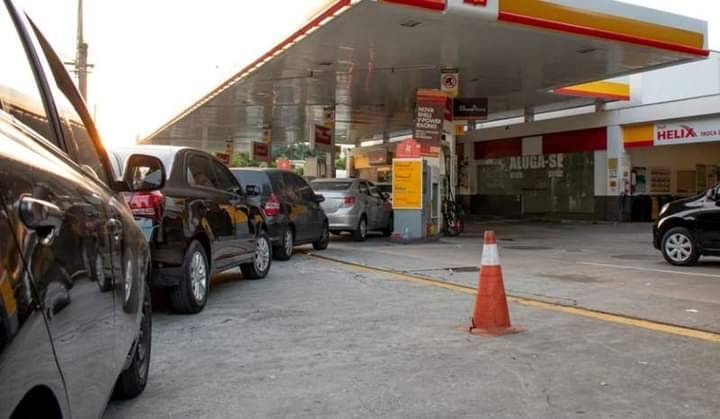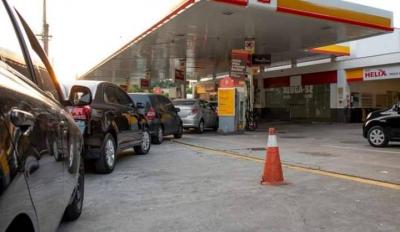The Lebanese are like someone thrown from the edge of a cliff into an abyss with no visible bottom or end. The more they continue to fall, the more they strip away from something. From public services. From a social safety net. From rights... causing an increase in burdens, the last of which will be the complete lifting of subsidies on a vital product like gasoline and its pricing in market dollars, costing Lebanese citizens an additional 127,000 Lebanese pounds for each tank.
Officially, Lebanon's central bank governor, Riad Salameh, yesterday washed his hands of the fuel sector, leaving gasoline prices susceptible to the fluctuations of the free market dollar exchange rate, which has no ceiling. Salameh has liberated the "Sayrafa" platform from the burden of financing gasoline imports but subjected society and the economy once again to the impact of occurrences and the speculations of currency traders and traders in the parallel market, causing the exchange rate to approach 36,000 Lebanese pounds.
In a unilateral decision communicated to oil import companies and the Ministry of Energy, the Central Bank decided to completely cease providing the necessary dollars for gasoline imports for traders and companies through "Sayrafa." These parties must now buy the dollars they need from the free market, where the dollar's price fluctuated yesterday around 36,000 Lebanese pounds. This move was not surprising, as the central bank had started, since the end of July, a policy of gradually abandoning gasoline financing. This began with reducing the percentage of dollars secured by "Sayrafa" for traders from 100% to 85%, then to 70%, and then 55%, continuing with a weekly reduction rate of 15%, until reaching 0% via "Sayrafa," with 100% now being purchased by importers from the parallel market.
Based on a direct request from the Central Bank, the Ministry of Energy issued new pricing for oil derivatives to reflect the abandonment of gasoline subsidies, after Salameh eliminated any margin for the ministry to operate in pricing, as long as the primary price drivers are the price of the dollar in the free market and world gasoline prices. According to the new pricing, gasoline prices rose by 20,000 pounds yesterday, reaching 638,000 pounds per tank of 95 octanes, in the morning pricing calculation, coinciding with the market dollar recording an exchange rate equivalent to 35,250 pounds, which is about 18 dollars per tank. If the financing via "Sayrafa" were still 100% in effect as it was before the end of July, the price of the tank would have been 511,200 pounds, or about 127,000 pounds less than it is today.
One consequence of Salameh's decision is that the price of a gasoline tank is more likely to rise than ever before, since the governor redirected the gasoline importers’ demand for dollars from "Sayrafa" to the free market, estimated to be worth about 200 million dollars per month to meet their import needs. This will stimulate an increase in the dollar's price itself adhering to the supply and demand rule, leading to a continuous increase in gasoline prices, especially since the importer and the station are purchasing it in dollars. This indicates the beginnings of a new phase of confusion regarding fuel pricing at stations and concerns about instability in product availability, as the price of the dollar may change significantly within a single day.
The Ministry of Energy hopes to stabilize pricing by issuing two gasoline pricing tables weekly, similar to diesel and gas, without ruling out the issuance of two daily tables if the free market dollar price fluctuates by more than 500 pounds or if global oil prices change by certain rates.
The calculation of gasoline prices originally includes global oil prices and their fluctuations, the free market dollar exchange rate and its changes, and fixed costs in pounds within the pricing structure table. In the upcoming days, it might also be affected by fluctuations related to changes in local margins for distribution companies and station owners, who are raising concerns about covering the total gasoline price based on the rising free market dollar price, while stations receive about 5% of the tank’s price. Some small, non-oil-importing station owners threaten to close their doors if the Ministry of Energy does not adjust the margin value, which remains a subject of discussion and debate between both parties to avoid a sales halt and the return of long queues.
This is not the first time Salameh has adopted a gradual liberalization approach for the prices of imported goods; it has been a policy pursued by the central bank since the days of subsidies. This policy was implemented for diesel prices to become at cash dollar rates, amidst talk of a funding card that has yet to materialize. It has also been applied to drug prices. Meanwhile, the ruling clique remains indifferent to the repercussions of these actions on society, as rising fuel prices will impact the economic cycle, transportation costs, delivery of goods and production, and increase all price indices.
As for "Sayrafa" itself, the cost of financing through it has been estimated over the past six months to range between 4 billion and 5 billion dollars, drawn from the mandatory reserves of the Central Bank, which the governor himself claims is around 12 billion dollars, meaning "Sayrafa" has consumed a third of the central bank’s savings. It is financed from two sources: the dollars stemming from external remittances circulating in the market and mandatory reserve dollars. This means the central bank pumps dollars from reserves into it, and from there into the market. After Salameh crippled monetary policy and the banking sector, traditional intervention mechanisms in the market, such as controlling reserve prices and interest rates, were disrupted. The "Sayrafa" platform has emerged as the only intervention technique for the Central Bank, through which it created a role for itself in supporting the exchange rate or increasing public sector employees’ salaries while supporting this commodity and liberalizing another. Through it, he intervenes by his own decision in monetary, financial, and economic policies, as is occurring today concerning the liberalization of gasoline.




